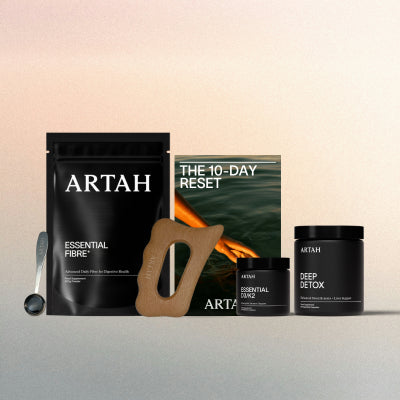Good sleep, minimal alcohol, regular exercise, the avoidance of smoking, and good nutrition; these have long been accepted as the lifestyle factors that contribute to a healthy life, but it turns out that these factors just scratch the surface. There's a new field of science in town, and it’s the science of longevity. The aim of this science is to improve how we experience our life by extending not only our lifespan but health span, and it has identified a set of distinct cellular mechanisms that contribute to cellular ageing and age-related decline. These processes cause a set of molecular changes that control how fast or slow the body breaks down — and they’re called the Hallmarks of Ageing.
Health and longevity are our default state. Likewise, disease and accelerated ageing don’t happen by accident, they're the body's response to unfavourable conditions. The ten hallmarks that have been identified each represent a fundamental biological process of ageing that help explain why and where things may go wrong. Like everything in health, these hallmarks don't operate in isolation; they're interconnected and influenced by various factors. Imbalances, whether excess or deficiency, impact how the hallmarks manifest, and in turn can speed up the ageing process. It's important to understand these signs of ageing and their impact on our health span, and even more importantly, to recognise how we can work with the hallmarks to not only counteract, but even reverse the effects of ageing.
Below we introduce the ten hallmarks of ageing, to shed light on their profound impact on physical and mental longevity:
1. Dysregulated Nutrient-Sensing
Our bodies have intricate mechanisms for monitoring our environment and detecting nutrient levels, including sugars, amino acids and fats. These sensing pathways continuously orchestrate chemical reactions in response to this information, deciding between things like triggering autophagy (cellular clean up), initiating protein synthesis, liberating fat storage or increasing fat storage. But how does the body know what action to take?
Enter the three main nutrient-sensing systems: insulin and its signalling pathway, mTOR, and AMPK(1). These systems work together to maintain cellular health and improve defences against disease. Exercise, whole food prioritisation, and fasting hacks have emerged as pivotal lifestyle factors that we can use to optimise these nutrient sensing systems. For example, intermittent fasting and FMDs can stimulate autophagy. Likewise, prioritising whole foods rich in high-quality proteins, healthy fats, and essential nutrients can activate mTOR pathways and initiate protein synthesis1. These pathways can also be boosted by targeted phytonutrients; Berberine, for example, has been shown to activates the AMPK pathway(2). A disruption in nutrient-sensing pathways is a trigger for disease, for example as seen in Type 2 Diabetes and insulin resistance.
2. Genome Instability and DNA Mutations
Every day, thousands of minor damages occur to our DNA, accelerating the ageing process as they accumulate. Fortunately, our bodies have built-in repair systems that work hard to fix this damage3. But even if they fix most of them, the ones left behind add up over time. As our cells divide, they make copies of DNA and occasionally replication errors can occur, leading to mutations (3). These mutations can disrupt normal function that can potentially lead to cancer or other deviations to normal function. Genome instability is just a term for this damage to our DNA, which is a key contributor to cellular ageing.
Minimising exposure to DNA-damaging factors is critical. This involves reducing or eliminating sources that subject our DNA to harm including UV-rays, ulta processed food, alcohol and other sources of food-source carcinogens, and environmental toxins(3).
3. Telomere Degradation
Chromosomes are thread like structures that hold our DNA, or genetic material. At the end of each chromosome is a protective cap, called a telomere, which gradually shrinks as we age. As they shrink, their ability to safeguard our DNA declines, leaving it vulnerable to unravelling(3). With each instance of cell replication, these protein structures naturally degrade, shortening the telomeres until the cell undergoes programmed cell death, called apoptosis3. The length of our telomeres plays a pivotal role in how long our DNA can successfully replicate; longer telomeres equate to more years of robust cellular function, while shorter ones indicate a potentially shorter lifespan and health span.
Good news; we have considerable influence over the state of our telomeres. Certain lifestyle choices speed up their shortening, including consuming a diet rich in ultra-processed foods, sugar, exposure to environmental toxins, lack of exercise, excess alcohol and chronic stress (there’s a pattern here). But, switching to a healthy diet, regular exercise, mindfulness, enough sleep (7-9 hours), and strong social bonds can lengthen telomeres, keeping our cells healthier for longer(3). Intermittent fasting and fasting mimicking protocols are of interest in the world of telemores as well, as both have been shown to improve telomere health and metabolic health in humans.
4. Protein Breakdown
DNA holds the blueprint for proteins, which in turn, govern virtually every aspect of our biology. Organs and hormones to neurotransmitters and muscle; they are all made up of proteins. Many proteins have short life spans and are susceptible to damage from the same factors that harm DNA, and when these proteins become damaged, they breakdown and their functionality can suffer. Conditions related to ageing, like Alzheimer's disease (AD) and Parkinson's disease (PD), are linked to these damaged proteins (3).
Autophagy, our cellular clean-up mechanism, is an important mitigator of protein damage, however, our lifestyle can often hinder this process. Continuous calorie intake and eating right before we go to bed fails to give our bodies that 12–14-hour window it needs for autophagy to take place (4). Eating at least three hours before bedtime and waiting 12 hours (minimum) before our next meal, or practicing intermittent fasting, is one of the best ways we can give our body the time it needs to repair damaged proteins (4).
5. Epigenetic Alterations
In the last decade, there’s been a massive paradigm shift in how we understand the role that our genes play in disease. Whilst our genes hold our genetic code and predispositions, it’s often the epigenetic factors that control whether these genes are expressed. Simply put, epigenetic alterations are changes in the instructions that control our genes, without changing the DNA sequence itself, that affect how genes are turned on or off and influence how cells function (3). Essentially, everything we do — from maintaining a healthy diet to getting sufficient sleep — can leave a mark on our genetic code, and exposure to stressors (like diet and toxins) are reflected in this code. Picture the epigenome as a perceptive listener, diligently incorporating all it encounters into our genetic makeup, where it can either accelerate or slow the ageing process (4).
6. Mitochondrial Dysfunction
Mitochondria are tiny structures present in every cell of our body and are responsible for energy production and metabolic balance3. They’re often referred to as the ‘powerhouse’ of our cells, and they need to be functioning well for optimal cellular health. Mitochondrial dysfunction has been linked with age conditions like Parkinson’s Disease, metabolic syndrome, infertility, genomic instability and more. When it comes to lifestyle modifications, the same pattern applies here, but there are also core nutrients that are essential to mitochondrial health, like Omega 3 fats, specialised nutrients like L Carnitine and Alpha Lipoic Acid, and other antioxidants. We can produce new mitochondria through exercise, adding another reason to the list of benefits of maintaining a good routine of strength and cardio.
7. Dysbiosis
Dysbiosis occurs when the balance of harmful bacteria outweighs beneficial microbes in our gut5. Because one of the key roles of our beneficial bacteria is to maintain the integrity of our gut lining, dysbiosis can wreak havoc on our metabolic health. Our gut barrier helps prevent bacteria, pathogens, and toxins from leaking into our bloodstream6. When these harmful substances enter the blood, they can trigger inflammation, which in turn generates harmful reactive oxygen species (ROS), and immune dysregulation, which are linked to accelerated ageing (7).
When it comes to a health microbiome, think fibre, fermented foods, and diversity. Consuming fermented foods like sauerkraut, miso, kombucha, kefir, and yogurt can introduce beneficial microbes into our digestive system. Additionally, including a variety of fibre-rich (think 30g per day) and polyphenol-rich foods in our diet, such as colourful fruits and vegetables, provides nourishment for these beneficial gut bacteria. If dysbiosis does take hold, it’s important to address the imbalance with herbal antimicrobials, like those in GI Cleanse, and reduce inflammation with beneficial bacteria and botanicals, like those in Biome Restore.
8. Chronic Inflammation
Inflammation is a normal and necessary part of our biology, but much like stress, it is supposed to be fleeting. Chronic inflammation is when the body's inflammatory response continues over time without being resolved or controlled. It's a low-level, ongoing reaction that we know now is a risk factor to numerous diseases, including age-related decline (8). Chronic inflammation can be influenced by a dietary pattern that is high in refined sugars, saturated fats, trans fats, and low in fruit, vegetables, and fibre. This pattern has been associated with a higher production of pro-inflammatory molecules (8). Obesity, chronic stress and sleep disorders are also both risk factors for and exacerbated by inflammation8. The positive spin is that we possess the ability to activate our body's anti-inflammatory pathways using the same methods that initially triggered the inflammation. Including healthy fats, such as, avocado, olive oil, and oily fish releases anti-inflammatory compounds like resolvins, alongside anti-inflammatory botanicals like turmeric and ginger, all of which help counteract and neutralise inflammation in the body (9). Additionally, reducing cortisol levels through mindfulness practices and optimising sleep can effectively halt chronic inflammation in its tracks.
9. Stem Cell Exhaustion
Stem cell exhaustion has two parts: a decrease in the number of stem cells and a decline in their ability to function (3). Stem cells have the remarkable ability to develop into various types of cells in the body, such as, nerve cells, or blood cells, and have the capacity to repair damaged tissues and organs (10). In essence, stem cells play a vital role in the body's natural healing and regeneration processes. As we grow older, so do our stem cells due to accumulating DNA damage (3). Their capacity to repair and regenerate our cells like they once did, diminishes over time. Whilst lifestyle modifications can slow the decrease in stem cells and current stem cell therapies show promise in potentially mitigating certain aspects of ageing (10), further research is needed to fully understand the long-term side effects and potential of stem cell therapies in slowing ageing.
10. Cellular Senescence
When cells reach old age, they undergo a programmed cell death, known as apoptosis. This process helps eliminate old cells to make way for fresh ones, and is a healthy part of our metabolism (4,11). However, there are times when cells avoid death, a phenomenon referred to as cellular senescence. Over time, these senescent cells – colloquially known as zombie cells - travel throughout our bodies, releasing pro-inflammatory molecules that can cause harm to nearby cells, and are implicated in nearly every age-related disease, like dementia and diabetes. Excessive stress, exposure to environmental toxins, a sedentary lifestyle and a poor diet can exacerbate cellular senescence.
Final Thoughts
The hallmarks of ageing encompass a range of interconnected processes that contribute to the ageing process and increase the risk of age-related diseases. However, what's empowering is that many of these hallmarks are within our control through lifestyle modifications. By adopting healthy habits, such as, maintaining a balanced diet, engaging in regular exercise, managing stress effectively, prioritising sufficient sleep, and avoiding harmful habits we can positively influence these hallmarks. While aging is inevitable, the choices we make can significantly influence how we age and the extent to which age-related diseases will impact our quality of life.
Disclaimer: The information presented in this article is for educational purposes only and is not intended to diagnose, prevent, or treat any medical or psychological conditions. The information is not intended as medical advice, nor should it replace the advice from a doctor or qualified healthcare professional. Please do not stop, adjust, or modify your dose of any prescribed medications without the direct supervision of your healthcare practitioner.
References:
- Guo, J., Huang, X., Dou, L. et al. Aging and aging-related diseases: from molecular mechanisms to interventions and treatments. Sig Transduct Target Ther 7, 391 (2022).
- Kazmirczak F, Hartweck LM, Vogel NT, Mendelson JB, Park AK, Raveendran RM, O-Uchi J, Jhun BS, Prisco SZ, Prins KW. Intermittent Fasting Activates AMP-Kinase to Restructure Right Ventricular Lipid Metabolism and Microtubules. JACC Basic Transl Sci. 2023 Feb 20;8(3):239-254.
- Schumacher B, Pothof J, Vijg J, Hoeijmakers JHJ. The central role of DNA damage in the ageing process. Nature. 2021 Apr;592(7856):695-703.
- Hyman M. Young Forever: The Secrets to Living Your Longest, Healthiest Life. Little, Brown Spark. 2023
- DeGruttola AK, Low D, Mizoguchi A, Mizoguchi E. Current Understanding of Dysbiosis in Disease in Human and Animal Models. Inflamm Bowel Dis. 2016, 22(5):1137-50.
- Camilleri M. Leaky gut: mechanisms, measurement and clinical implications in humans. Gut. 2019 Aug;68(8):1516-1526.
- Li L, Peng P, Ding N, Jia W, Huang C, Tang Y. Oxidative Stress, Inflammation, Gut Dysbiosis: What Can Polyphenols Do in Inflammatory Bowel Disease? Antioxidants (Basel). 2023 Apr 20;12(4):967.
- Pahwa R, Goyal A, Jialal I. Chronic Inflammation. StatPearls Publishing. 2024
- Grosso G, Laudisio D, Frias-Toral E, Barrea L, Muscogiuri G, Savastano S, Colao A on behalf of the Obesity Programs of Nutrition, Education, Research and Assessment (OPERA) Group. Anti-Inflammatory Nutrients and Obesity-Associated Metabolic-Inflammation: State of the Art and Future Direction. Nutrients. 2022; 14(6):1137
- Zakrzewski W, Dobrzyński M, Szymonowicz M, Rybak Z. Stem cells: past, present, and future. Stem Cell Res Ther. 2019. 26;10(1):68.
- Kumari R, Jat P. Mechanisms of Cellular Senescence: Cell Cycle Arrest and Senescence Associated Secretory Phenotype. Front. Cell Dev. Biol. 2021


















































